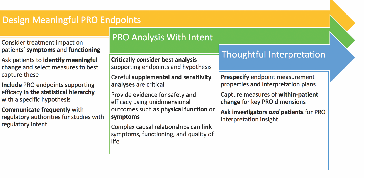PROactive—Linking Design, Analysis, and Interpretation of Patient-Reported Outcomes in Clinical Trials
Stephanie Manson PhD, HEOR Excellence, Novartis, East Hanover, NJ, USA; Jessica Roydhouse PhD, Menzies Institute for Medical Research, University of Tasmania, Hobart, Australia; Pallavi Mishra-Kalyani PhD, US Food and Drug Administration, Center for Drug Evaluation and Research, Office of Biostatistics, Silver Spring, MD, USA; Donald Stull PhD, Independent HEOR Consultant, Seattle, WA, USA
Designing Meaningful PRO Endpoints
In designing patient-reported outcomes (PRO) endpoints, the first step is to think about how patients’ symptoms and functioning will likely be affected by the drug (Figure). Next, it is important to speak to patients to understand which of these changes will be most impactful. Instrument selection should not necessarily be based on what similar trials have used, but instead on which instrument provides the best insight into the key domains of interest.
"A good patient-reported outcomes strategy requires specificity, planning, and forethought. Linking PRO endpoints, analysis, and potential interpretations from the start helps make the most of patient insights collected from PROs within the trial."
PRO endpoints should have a clear specification of what will be measured, how it will be measured, and what clinically relevant change looks like, as well as a prespecified hierarchy of PRO endpoints. It is unlikely that PRO endpoints supporting efficacy will be included in the US Prescribing Information unless they are included in the statistical hierarchy with a specific hypothesis. Spending type I error is not a decision taken lightly, so possible PRO endpoints need to be considered carefully. For example, prospective efforts should be made to guarantee appropriate data collection for an interpretable data analysis. For studies with regulatory intent, frequent communication with regulatory authorities is encouraged to help ensure the design and analysis plan will answer the research objective and adequately characterize the PRO endpoints of interest. In addition to efficacy, there may be instances where PROs provide complementary descriptive information about tolerability, as was the case with crizotinib for lung cancer (ocular toxicities).
PRO Analysis With Intent
When designing the analysis plan, it is important to critically consider which analysis is best suited to the endpoints and the hypothesis of interest. Furthermore, analytic challenges that may result from trial design or clinical context, such as asymmetric missing data or dropout, knowledge of treatment assignment, or frequency of assessment need to be considered at the design phase. Including careful supplemental and sensitivity analyses to address potential biases or concerns and demonstrate the robustness of the analysis is likewise important. Prevention is key but planning for possible contingencies arising from these issues (such as missing assessments due to unexpected intercurrent events) is not a waste of time. Different therapeutic contexts may require different analyses and endpoints, highlighting the importance of good design and early communication with patients to understand what you will be analyzing.
"To ensure meaningful interpretation, the outcome of interest should capture measures within patient change."
A common challenge in the analysis of PRO data from clinical trials is the use of the broad, multidimensional outcomes such as health-related quality of life as endpoints. Providing evidence for safety and efficacy is more straightforward if unidimensional outcomes such as physical function or symptoms are used. With multidimensional outcomes such as health-related quality of life, analysts should consider the complexity of relationships among its different aspects. Recent research shows that some symptoms affect other symptoms, which in turn affect patient functioning, which affects patient quality of life.1 Thinking about the logical causal flow of relationships from the symptom to quality of life would likely suggest that it is a more complex relationship. For example, nausea likely affects vomiting, and both will result in increased fatigue, which will result in reduced physical functioning, which will lead to poorer quality of life. More complex analytic approaches may be required to evaluate multidimensional constructs such as health-related quality of life, and well-defined unidimensional outcomes will be more useful when thinking about efficacy.
Thoughtful Interpretation
As part of the analysis plan, measurement properties of the endpoints and a plan for the interpretation of the estimation of effect should be prespecified. To ensure meaningful interpretation, the outcome of interest should capture measures within patient change, if possible. This includes consideration of the indirect relationships among key dimensions of PROs and how to anticipate and interpret these results. In addition, careful attention should be paid to design elements, such as open-label design, that may affect interpretation of the results. Concerns have been expressed that patient knowledge of treatment assignment may affect their willingness to stay on trial, complete PRO measures, or impact their responses to the measures. Simple comparisons by treatment may be insufficient and require additional supplementary analyses to support interpretation.

Furthermore, identifying a clinically meaningful change is important. A highly recommended approach is anchor-based methods to investigate meaningful change thresholds, particularly when clinically meaningful change hasn’t been already established in the population. Anchor-based methods require an explicit definition of minimal importance by defining the anchor. This may be supplemented with descriptive representations such as the cumulative distribution function and probability density function or kernel density plot curves to derive the thresholds for meaningful change as a data-driven approach.
Once results are available, both investigators and patients can provide invaluable insight into the interpretation of PRO data. The key is to present the results simply and clearly so they can be easily understood. By following these simple steps, it is possible to have PRO results from clinical trials that communicate meaningful findings to regulators, payers, physicians, and most importantly, patients.

